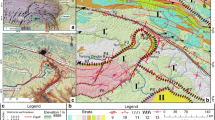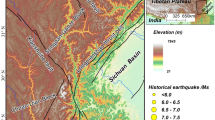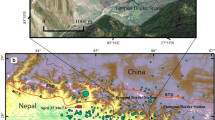Abstract
At 5: 39 AM on 24 June 2017, a huge landslide-debris avalanche occurred on Fugui Mountain at Xinmo village, Diexi town, Maoxian county, Sichuan province, China. The debris blocked the Songpinggou River for about 2 km, resulting in a heavy loss of both human lives and properties (10 deaths, 3 injuries, 73 missing, and 103 houses completely destroyed). The objectives of this paper are to understand the overall process and triggering factors of this landslide and to explore the affecting factors for its long term evolution before failure. Post event surveys were carried out the day after the landslide occurrence. Information was gathered from literature and on-site investigation and measurement. Topography, landforms, lithology, geological setting, earthquake history, meteorological and hydrological data of the area were analysed. Aerial photographs and other remote sensing information were used for evaluation and discussion. Eye witnesses also provided a lot of helpful information for us to understand the process of initiation, development and deposition. The depositional characteristics of the moving material as well as the traces of the movement, the structural features of the main scarp and the seismic waves induced by the slide are presented and discussed in detail in this paper. The results show that the mechanism of the landslide is a sudden rupture of the main block caused by the instability of a secondary block at a higher position. After the initiation, the failed rock mass at higher position overloaded the main block at the lower elevation and collapsed in tandem. Fragmentation of the rock mass occurred later, thus forming a debris avalanche with high mobility. This landslide case indicates that such seismic events could influence geological hazards for over 80 years and this study provides reference to the long term susceptibility and risk assessment of secondary geological hazards from earthquake.
Similar content being viewed by others
Change history
04 October 2017
Figure 7 is incorrect: Figure 7 Distribution of local slope gradients before (a) and after (b) the landslide.
04 October 2017
Erratum to: J. Mt. Sci. (2017) 14(9): 1689?1700
References
Chang KJ, Taboada A, Lin ML, Chen RF (2005) Analysis of landsliding by earthquake shaking using a block-on-slope thermo-mechanical model: example of Jiufengershan landslide, central Taiwan. Engineering Geology 80(1): 151–163. https://doi.org/10.1016/j.enggeo.2005.04.004
China Earthquake Administration (2008) The M8.0 Wenchuan earthquake seismic intensity map. (In Chinese) Available at: http://www.cea.gov.cn/manage/html/8a8587881632fa5c011 6674a018300cf/_content/08_09/01/1220238314350.html.
Cui P, Chen XQ, Zhu YY, et al. (2011) The Wenchuan earthquake (May 12, 2008), Sichuan province, China, and resulting geohazards. Natural Hazards 56(1): 19–36. https://doi.org/10.1016/S0013-7952(03)00125-X
Fan JR, Zhang XY, Su FH, et al. (2017) Geometrical feature analysis and disaster assessment of the Xinmo landslide based on remote sensing data. Journal of Mountain Science 14(9). https://doi.org/10.1007/s11629-017-4633-3
Feng WK, Hu YP, Xie JZ, et al. (2016) Disaster mechanism and stability analysis of shattered bedding slopes triggered by rainfall-a case study of Sanxicun landslide. Chinese Journal of Rock Mechanics and Engineering 35(11): 2197–2207. https://doi.org/10.13722/j.cnki.jrme.2016.0420 (In Chinese)
Feng WK, Xu Q, Huang RQ (2009) Preliminary study on mechanical mechanism of slope earthquake-induced deformation. Chinese Journal of Rock Mechanics and Engineering 28(S1): 3124–3130. (In Chinese)
Guzzetti F, Peruccacci S, Rossi M, et al. (2008) The rainfall intensity–duration control of shallow landslides and debris flows: an update. Landslides 5(1): 3–17. https://doi.org/10.1007/s10346-007-0112-1
Hu KH, Chen XZ, Ge YG, et al. (2017) Landslides Triggered by the Ms6.5 Ludian, China Earthquake of August 3, 2014. In: Mikoš M, Casagli N, Yin Y, Sassa K. (eds) Advancing Culture of Living with Landslides. WLF 2017. Springer, Cham.
Huang RQ, Li WL (2008) Research on development and distribution rules of geohazards induced by Wenchuan earthquake on 12th may, 2008. Chinese Journal of Rock Mechanics and Engineering 27(12): 2585–2592. (in Chinese)
Huang RQ, Li WL (2008) Research on development and distribution rules of geohazards induced by Wenchuan earthquake on 12th May, 2008. Chinese Journal of Rock Mechanics and Engineering 27(12): 2585–2592. (In Chinese)
Huang RQ, Feng WK (2009) Geohazard assessment of the Wengchuan earthquake. Science Press. pp 599–600. (In Chinese)
Huang RQ, Pei XJ, Li TB (2008). Basic characteristics and formation mechanism of the largest scale landslide at daguangbao occurred during the wenchuan earthquake. Journal of Engineering Geology 16(6): 730–741. (In Chinese)
Huang RQ, Zhang WF, Pei XJ (2014) Engineering geological study on Daguangbao landslide. Journal of Engineering Geology 22(4): 557–585. (In Chinese)
Huang ZZ, Tang RC, Liu SL (2002) Re-discussion of the Seismogenic Structure of the Diexi Large Earthquake in 1933 and the Arc Tectonics on Jiaochang, Sichuan Province. Eaqthquake Research in China 18(2): 183–192. (In Chinese)
Jibson RW, Harp EL, Michael JA (2000) A method for producing digital probabilistic seismic landslide hazard maps. Engineering Geology 58(3): 271–289. https://doi.org/10.1016/S0013-7952(00)00039-9
Kang W (2011) Location and focal mechanism of the 1933 diexi earthquake and its associated regional tectonics. Acta Seismologica Sinica 33(5): 557–567. (In Chinese) https://doi.org/10.3969/j.issn.0253-3782.2011.05.001
Keefer DK (1984) Landslides caused by earthquakes. Geological Society of America Bulletin 95(4): 406–421.
Keefer DK (2002) Investigating landslides caused by earthquakes–a historical review. Surveys in Geophysics 23(6): 473–510. https://doi.org/10.1023/A:1021274710840
Li WY, Liu C, Scaioni M, et al. (2017). Spatio-temporal analysis and simulation on shallow rainfall-induced landslides in China using landslide susceptibility dynamics and rainfall I-D thresholds. Science China Earth Sciences 60: 720–732. https://doi.org/10.1007/s11430-016-9007-2
Lin CW, Liu SH, Lee SY, Liu CC (2006) Impacts of the Chi-Chi earthquake on subsequent rainfall-induced landslides in central Taiwan. Engineering Geology 86(2): 87–101. https://doi.org/10.1016/j.enggeo.2006.02.010
Lin CW, Shieh CL, Yuan BD, et al. (2004) Impact of Chi-Chi earthquake on the occurrence of landslides and debris flows: example from the Chenyulan River watershed, Nantou, Taiwan. Engineering geology 71(1): 49–61. https://doi.org/10.1016/S0013-7952(03)00125-X
Ouyang CJ, Zhao W, He SM, et al. (2017) Numerical modeling and dynamic analysis of the 2017 Xinmo landslide in Maoxian County, China. Journal of Mountain Science 14(9). http://doi.org/10.1007/s11629-017-4613-7
Pasuto A, Silvano S (1998) Rainfall as a trigger of shallow mass movements. A case study in the Dolomites, Italy. Environmental Geology 35(2): 184–189.
Regmi AD, Dhital MR, Zhang JQ, et al. (2016) Landslide susceptibility assessment of the region affected by the 25 April 2015 Gorkha earthquake of Nepal. Journal of Mountain Science 13(11): 1941–1957. https://doi.org/10.1007/s11629-015-3688-2
SqueeSAR™ measurements over the landslide area (2017) The displacement time series superimposed reveals clear precursory movements months before the event. http://trealtamira. com/news/data-focus-precursor-maoxian-landslidemeasured-space/
Tang RC, Lu LK (1981) On the seismogeological characteristics of 1976 songpan-pingwu earthquakes. Seismology and Geology 3(2): 41–47. (In Chinese)
Tang RC, Jiang NQ, Liu SL. (1983) Recognition of the geological setting and the seismogenic condition for the Diexi magnitude 7.5 earthquake. Journal of Seismological Research 6(3): 327–338. (In Chinese)
Wang GH, Sassa K (2003) Pore pressure generation and movement of rainfall induced landslides: effects of grain size and fine-particle content. Engineering Geology 69(1/2): 109–125. https://doi.org/10.1016/S0013-7952(02)00268-5
Wang L, Yang L, Li T, et al. (2000) Evolution mechanism of Jiaochang earthquake landslide on Ming River and its controlling. Journal of Geological Hazards and Environment Preservation 11(3): 195–199. (In Chinese)
Xu C, Xu XW, Shyu JBH, et al. (2015) Landslides triggered by the 20 April 2013 Lushan, China, Mw 6.6 earthquake from field investigations and preliminary analyses. Landslides 12(2): 365–385. https://doi.org/10.1007/s10346-014-0546-1
Xu WJ, Xu Q, Hu RL (2011) Study on the shear strength of soil–rock mixture by large scale direct shear test. International Journal of Rock Mechanics and Mining Sciences 48(8):1235–1247. https://doi.org/10.1016/j.ijrmms.2011.09.018
XU WJ, Xu Q, Wang YJ (2013) The Mechanism of High-speed Motion and Damming of the Tangjiashan Landslide. Engineering Geology 157: 8–20. https://doi.org/10.1016/j.enggeo.2013.01.020
Xu XN, Wang LS (2005) On the mechanism of slope deformation-failures and their distribution characteristics in a high earthquake-intensity area. Journal of Engineering Geology 13(1): 68–75. (In Chinese)
Zeng S, Li ZC, Wei H, et al. (2013) Stability analysis of red sandstone bedding slope under rainfall infiltration and drywet cycling. Rock and Soil Mechanics 34(6): 1536–1542. (In Chinese)
Zhou JW, Cui P, Yang XG, et al. (2013) Debris flows introduced in landslide deposits under rainfall conditions: The case of Wenjiagou gully. Journal of Mountain Science 10(2): 249–260. https://doi.org/10.1007/s11629-013-2492-0
Acknowledgement
This study was financially supported by the National Basic Reareach program of China (973 program, Grant No. 2013CB733201), Key Research Program of Frontier Sciences, CAS (Grant No. QYZDY-SSW-DQC006) and the “Hundred Talents” program (SU Li-jun) of Chinese Academy of Sciences (CAS). Professor ZHAO Yong from China Earthquake Networks Center is specially appreciated for his courtesy of providing the data of Seismic wave signal at the Maoxian station.
Author information
Authors and Affiliations
Corresponding author
Rights and permissions
About this article
Cite this article
Su, Lj., Hu, Kh., Zhang, Wf. et al. Characteristics and triggering mechanism of Xinmo landslide on 24 June 2017 in Sichuan, China. J. Mt. Sci. 14, 1689–1700 (2017). https://doi.org/10.1007/s11629-017-4609-3
Received:
Revised:
Accepted:
Published:
Issue Date:
DOI: https://doi.org/10.1007/s11629-017-4609-3




